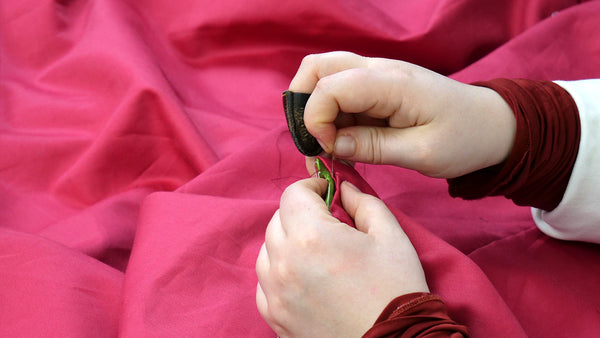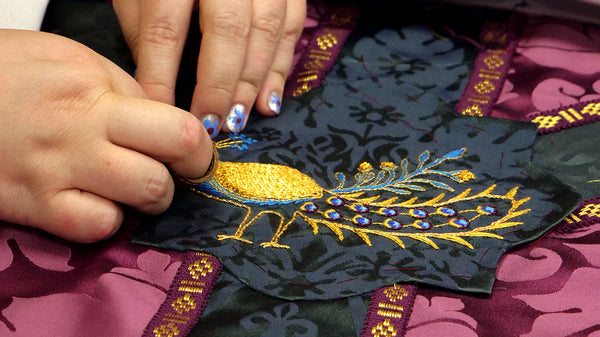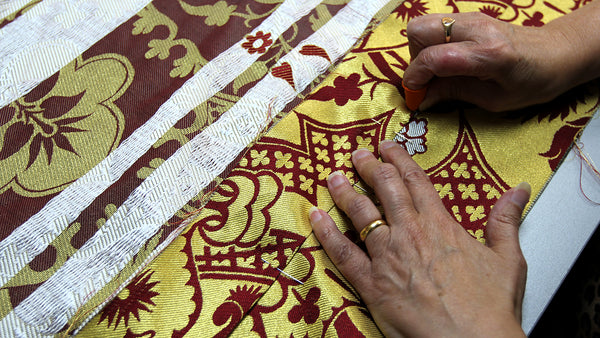Watts & Co has grown from strength to strength, consistently drawing on tradition and looking to the future with a refined blend of historicism and invention. What is rare for many is integral for Watts: namely, that the workroom and showroom share the same space, with the UK’s finest craftspeople always on hand. Embroidery and tailoring are always done on site and by hand, with the greatest care and unsurpassed technical skill. The diverse techniques and close attention to detail, which must be carefully mastered in order to become competent in embroidering and sewing, cannot be underestimated. To learn more about this important aspect of Watts’ history, we invite you to obtain a copy of textile historian Mary Schoeser’s excellent book on the subject through our website
Watts & Co has led the way in the fusion of inspiration from England’s medieval past with materials, designs and methods firmly rooted in the Victorian period and consistently in development to suit the fashion and taste of the day. Whether minutely intricate or flamboyantly bold, the colour and thread combinations in Watts’ fabrics and embellishments are unparalleled and unmistakable.

Always willing to meet demand and make careful changes to address modern needs, Watts opened a tailoring department in 1985. This ensured made to measure cassocks, albs, clerical shirts and all manner of ecclesiastical wear are always the perfect fit and cut from the finest materials. Now, in 2023, we have completed our largest expansion yet: the addition of a second workroom site for our outfitting production.
Watts was founded in the same era that the Royal School of Needlework began and that women throughout the UK were developing increasingly structured and detailed approaches to stitching and embroidery. In addition to manuals on needlecraft and illustrated records of medieval needlework, architects such as A. W. N. Pugin and G. E. Street promoted the revival of this key element of Gothic aesthetics and theological textiles. Moreover, in addition to its own on-site embroiderers and embroidery school, the architects associated with Watts & Co worked with several British convent communities.
These Anglican nuns, established from the mid-nineteenth century in the wake of the Oxford Movement’s revivification of the Church of England’s pre-Reformation traditions, ran workrooms and taught students. Thus, alongside those in the Watts & Co workroom, convents also contributed to a growing and invaluable revival of ecclesiastical embroidery techniques on a scale unseen since the Middle Ages. Designs produced and hand-sewn at Watts & Co were objects of the highest quality that had ever been achieved in the art.

One of the little-known secrets of Watts & Co dates back to the firm’s earliest years. In the last decades of the nineteenth century, Japan – which had previously isolated itself from extensive trade – opened its doors to the west and displayed its unique art and design to the world. A fascination with Japan is one of the distinguishing features of the decadent Aesthetic Movement. The painter Dante Gabriel Rossetti used Japanese-style tiles and a koto – a Japanese stringed instrument – in his famed painting The Blue Bower. James McNeill Whistler and Albert Moore also used Japanese motifs and colour palettes in much of their work. G. F. Bodley, one of Watts & Co’s founders, mixed in these Aesthetic circles and knew its prominent figures well. Early in his career he had been so closely associated with William Morris and Edward Burne-Jones that he had given Morris, Marshall, Faulkner & Co its first ecclesiastical stained glass commissions and was nearly a founding partner.
The founders of Watts & Co were as inspired by the Gothic Revival and its motives as they were by the Aesthetic Movement and its unendingly eclectic pursuit of beauty. At the London International Exhibition of 1862, Japanese decorative and fine art objects took the UK by storm. It was here that Watts founder G. F. Bodley discovered Japanese gold thread, a shimmering, fine cord consisting of silk surrounded by pure gold. Its ability to be flexibly worked at even the finest ornamental details and to reflect flickering candlelight is absolutely unique. Watts & Co use it exclusively in their workroom to this day.

Since its establishment in 1874 by three architects concerned with the beauty of holiness, Watts & Co has consistently led the way with internationally renowned fabrics and designs. Watts & Co offers a select yet diverse range of ecclesiastical textiles and furnishings, including frontals, banners, copes, mitres, burses, veils, chasubles, dalmatics, maniples and stoles. These can be ordered from classic ranges in any combination of co-ordinating fabrics and trimming.
These products often feature bespoke embroidery done in the best taste incorporating ancient motifs and symbols to complement any holy occasion from daily worship to festal celebrations. Watts & Co also uses its own signature style of trim and braiding, with motifs derived from authentic medieval sources.
In addition to its unparalleled status in the UK, the firm’s finest work can be found in cathedrals and parishes the world over, from America to Australia.

This unique company has led the way in developing bespoke items of exquisite taste, blending tradition and innovation in order to create objects of timeless beauty.
